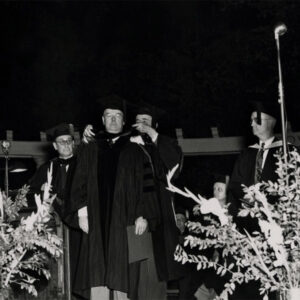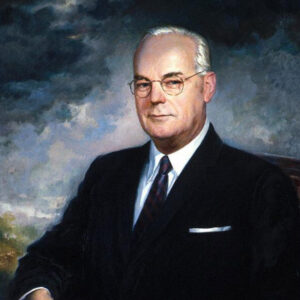calsfoundation@cals.org
John Wesley Snyder (1895–1985)
John Wesley Snyder was the secretary of the Treasury in the administration of President Harry S. Truman. He holds the distinction of being the first native-born Arkansan to hold a Cabinet post.
John W. Snyder was born in Jonesboro (Craighead County) on June 21, 1895. The third of six children of Jerre Hartwell Snyder and Ellen Hatcher Snyder, Snyder obtained his early education through high school in Jonesboro and later attended Vanderbilt University’s School of Engineering from 1914 to 1915. Because of finances, he quit and returned to Arkansas, moving to Forrest City (St. Francis County). He taught in a country school in nearby Palestine (St. Francis County), often walking several miles to get to the classes he taught.
Later in 1915, the United States quietly began to make early preparations for World War I, already raging in Europe. Snyder and a friend volunteered for the army. They were shipped to Fort Logan H. Roots in North Little Rock (Pulaski County). Having one year of college in an era when even high school diplomas were rare, as well as an engineering background, he convinced his superiors that he would be of more use in the artillery and was transferred, eventually serving with distinction as an officer in the Thirty-second Artillery. He saw action in five different sectors of the Western Front and was decorated for his service by both the United States and France. During his service in the artillery, he became friends with other noted Americans such as boxer Gene Tunney, America’s “ace of aces” fighter pilot Eddie Rickenbacker, and future president Dwight Eisenhower.
Snyder was mustered out of the army in 1919 and returned to Arkansas after the war. He retained his commission as a captain and ultimately achieved the rank of colonel in the Army Reserve. During his military service, he met and became a lifelong friend of Harry S. Truman, who was also in the artillery.
On January 5, 1920, he married Carrie Evelyn Cook; they had one daughter. That same year, though his life plan was to return to school and become an electrical engineer, at the urging of his uncle, Snyder took his first job in the banking industry as a bookkeeper in a bank in Forrest City. During the next ten years, he advanced rapidly in his chosen profession, working as an officer of numerous banks in Arkansas and Missouri.
In 1931, Snyder entered government service, working in the Office of the Comptroller of the Currency in the “insolvency division.” His duties were, essentially, to attempt to rehabilitate banks that had gone bust during the Depression. He was tasked to monitor eight banks in the St. Louis, Missouri, area. Having achieved notable results in this effort, Snyder was named by President Franklin D. Roosevelt to be the head of the St. Louis branch of the Federal Loan Agency of the Reconstruction Finance Corporation (RFC) in 1937. After he served for a time in this post, the Roosevelt administration asked him to come to Washington DC as special assistant to the chairman of the RFC, a post that brought him into frequent contact with former army buddy Truman, who was now a senator from Missouri.
Snyder resigned his post in 1943 and briefly returned to St. Louis to become executive vice president of the First National Bank of St. Louis. He was to be promoted to president in the summer of 1945. However, upon the death of Roosevelt and the beginning of the Truman administration, Snyder agreed to return to Washington to help with the problems of World War II and its economic aftermath. He was named director of the Office of War Mobilization and Reconstruction to deal with the potential economic catastrophe resulting from the influx of returning GIs. This had the potential to leave eight million people unemployed—a situation that did not develop. When Secretary of the Treasury Fred M. Vinson resigned to become chief justice of the U.S. Supreme Court, Snyder was nominated for the vacated post by Truman and confirmed by the U.S. Senate. He served in that post from 1946 to the end of the Truman administration in 1953.
Snyder played a key role in formulating and implementing the recovery program for Europe known generally as the Marshall Plan. Moreover, he was tasked with establishing a stable economy in the United States. His program for this included a special concern for maintaining confidence in the credit of the government, reducing the federal debt, and encouraging public thrift through investment in U.S. savings bonds. The Truman administration assigned him to play a key role in the passage of the GI Bill, providing educational, medical, and other benefits to soldiers returning after World War II. Much of the boom period of the 1950s can be credited to the monetary policies implemented by Snyder in the late 1940s. In addition to the many official duties, Snyder also served on numerous boards and committees, including the boards of the Smithsonian Institution, the National Gallery of Art, the Franklin D. Roosevelt Library, the Postal Savings System, and the Federal Farm Mortgage Corporation.
In 1953, Snyder retired from the Department of the Treasury. He remained as a minor economic adviser in the following administrations but mostly engaged in private philanthropies and causes, such as the Boy Scouts of America; he also maintained a special relationship with Georgetown University which, upon his death, created the John W. Snyder Book Endowment Fund to purchase volumes for the library.
Snyder died at the age of ninety on October 8, 1985.
For additional information:
“John W. Snyder.” History of the Treasury: Secretaries of the Treasury. http://www.ustreas.gov/education/history/secretaries/jwsnyder.shtml (accessed April 26, 2022).
“Oral History Interview with John W. Snyder.” Harry S. Truman Library and Museum, Independence, Missouri. Online at http://www.trumanlibrary.org/oralhist/snyder.htm (accessed April 26, 2022).
Snyder, John W. “Biographical Address to the Craighead County Historical Society, June 10, 1968.” Arkansas State Archives, Little Rock, Arkansas.
Williams, Fay. Arkansans of the Years. Little Rock: C. C. Allard & Associates, 1951.
———. “John W. Snyder Is Still Just an Arkansas Boy.” Arkansas Democrat Sunday Magazine. June 25, 1950, pp. 1–2.
David O. Bowden
Little Rock, Arkansas
 Early Twentieth Century, 1901 through 1940
Early Twentieth Century, 1901 through 1940 Politics and Government
Politics and Government John W. Snyder
John W. Snyder  John Wesley Snyder
John Wesley Snyder 




Comments
No comments on this entry yet.